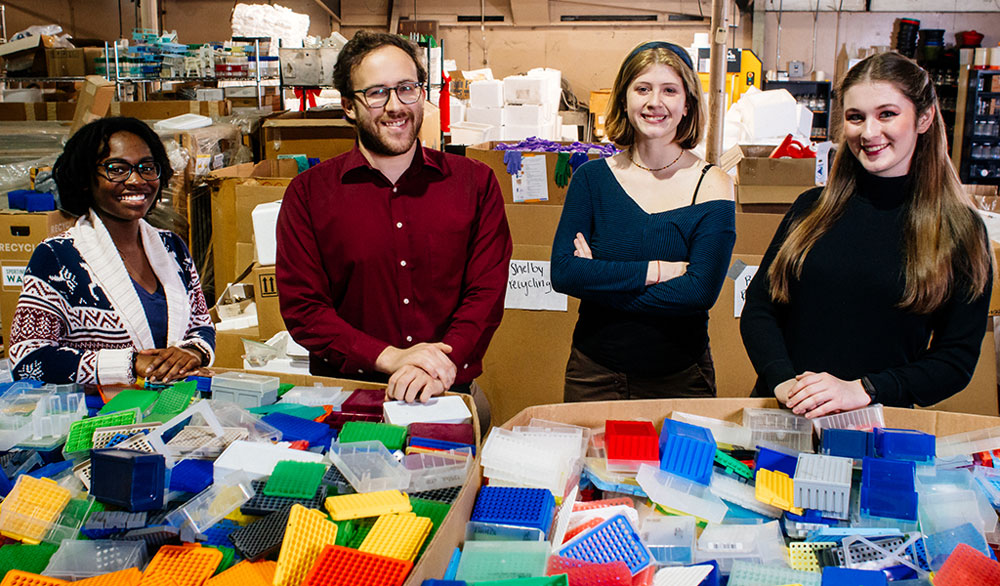 The Green Labs program is led by Nick Ciancio (second from left), UAB sustainability program coordinator, and Emily Colpack (right), Green Labs coordinator, who rely on student interns such as Alexia Wilson (left) and Elle Lohning (second from right) to collect recyclable materials from participating Green Labs labs across campus, including the pipette tip boxes shown here. Ciancio and Colpack have found a new vendor that can turn old pipette tip boxes into new pipette tip boxes. This is one of several new offerings for the award-winning Green Labs program at UAB.
The Green Labs program is led by Nick Ciancio (second from left), UAB sustainability program coordinator, and Emily Colpack (right), Green Labs coordinator, who rely on student interns such as Alexia Wilson (left) and Elle Lohning (second from right) to collect recyclable materials from participating Green Labs labs across campus, including the pipette tip boxes shown here. Ciancio and Colpack have found a new vendor that can turn old pipette tip boxes into new pipette tip boxes. This is one of several new offerings for the award-winning Green Labs program at UAB.
STEVE WOOD / University Relations
Research is all about finding new things, and UAB investigators lead the way. But they are also world-class at losing, too: shaving kilowatts, recycling supplies and dropping water usage in Olympic swimming pool-size quantities.
Each year, labs across the globe compete to see who can reduce their energy usage most in the Freezer Challenge. In 2021, more than 300 labs representing 113 different research institutions in 17 countries took part, saving a combined 4.3 million kilowatt-hours per year. The winner of the academic organization category: UAB, with the lab of Barbara Van Der Pol, Ph.D., selected as one of 12 individual honorees. The wins made UAB and the Van Der Pol lab ineligible for the top awards in the 2022 competition; instead, each took home Winning Streak awards, while the lab of Upender Manne, Ph.D., received the Small Lab Award in the academic organization category.
Top five globally
In this contest, “we are in a league of our own,” said Nick Ciancio, UAB sustainability program coordinator, who founded the university’s Green Labs program in 2016 when he was an undergraduate and intern with UAB Sustainability. Green Labs is a partnership between UAB Sustainability and Environmental Health and Safety. It began with an inaugural cohort of 18 participating labs; now there are more than 150 participating labs, Ciancio says, all certified by the nonprofit My Green Lab. “As it stands today, we have the most My Green Lab-certified labs of any university in the world,” Ciancio said. “And we are among the largest entities in the world, of any type — we rank in the top five globally.” In 2022, UAB also received the Lab Sustainability Award at the International Institute for Sustainable Laboratories annual conference.
Become a Green Lab
Email
Joining the UAB Green Labs program means meeting with Ciancio or Emily Colpack, the Green Labs coordinator, for a lab tour, after which the lab receives a list of suggested changes to energy consumption, waste production and water usage. (See "Sustainable lab practices," below, for common suggestions.) By making at least 40 percent of the suggested changes within six months, the lab becomes an official Green Lab and gets a sticker, a few inches square, to affix to the lab door. “Researchers know the Green Labs program,” Ciancio said. “They have learned throughout the years that we are not trying to compromise their safety or research. Safety is our first priority, then research integrity, then energy savings, in that order.”
“I have recycled at home for decades; but I didn’t know how to bring my personal commitments to energy efficiency, landfill waste reduction and sustainability into my research lab. The Green Labs program made this easy for me."
“Nick and his team have always done a great job of providing recommendations that are reasonable, then helping us to implement them,” said Lyse Norian, Ph.D., associate professor in the Department of Nutrition Sciences, who has been a member of Green Labs since the beginning in 2017. Norian’s lab studies “the effects of diet and obesity on immune responses to cancer, and ultimately on cancer immunotherapy outcomes,” she said. As soon as she heard about the program from Ciancio, “I knew I had to participate,” Norian said. “I have recycled at home for decades; but I didn’t know how to bring my personal commitments to energy efficiency, landfill waste reduction and sustainability into my research lab. The Green Labs program made this easy for me by providing guidance every step of the way.” (Hear more from principal investigators and their lab personnel about participating in Green Labs in this story.)
 Ciancio and Colpack have collected a vast assortment of glassware from departing labs that is available for any UAB lab to take for free. The beakers and flasks shown here are only a small sampling of what is available, Ciancio notes. (See just below for contact email and an online form to sign up for a visit.)
Ciancio and Colpack have collected a vast assortment of glassware from departing labs that is available for any UAB lab to take for free. The beakers and flasks shown here are only a small sampling of what is available, Ciancio notes. (See just below for contact email and an online form to sign up for a visit.)STEVE WOOD / University Relations
Four new initiatives
So what do you do if you are already on top? Find more savings and look to get more people involved. Ciancio and Colpack, channeling UAB’s focus on innovation, are not simply signing up labs for more of the same. One recent example focuses on lab glassware. Labs are filled with heat-resistant glassware that cannot be easily recycled, so if an investigator retires or moves to another institution, the glassware they leave behind often ends up at UAB Surplus or in the landfill. “A lot of consumables aren’t sent to Surplus because of the overwhelming amount of material,” Ciancio said. Colpack and Ciancio started gathering these expensive flasks and beakers in a vast collection at the Green Labs warehouse (next to the intramural fields) and offering them to newly hired investigators — or any existing lab. “There is no reason to spend thousands of dollars on glassware we already have,” Colpack said. (Email
Ciancio and Colpack are constantly partnering with researchers and other departments on campus to explore new initiatives. Norian and other Green Labs participants are open to trying new things, Ciancio says, and sometimes share their own ideas to explore. “Hearing the Green Labs team tell us how much energy just one of our ultra-low freezers uses, or how many kilowatt-hours of energy a typical lab consumes in a year, is very eye-opening,” Norian said. “And that has motivated me to keep working to reduce my lab’s environmental footprint.”
Below, Ciancio and Colpack share four new initiatives they are excited about.
1. Floating freezers
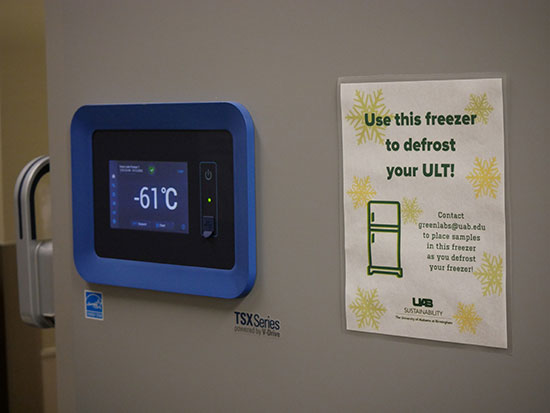 Some of the biggest energy users in a typical lab are the freezers needed to store samples, particularly ultra-low-temperature, or ULT, freezers capable of reaching –80 degrees Celsius. Over the years, freezers can collect a casing of ice an inch thick and dust blocking the coils, interrupting heat exchange and increasing the energy needed to cool. “Defrosting is a very important part of freezer maintenance,” Ciancio said. But a common issue facing researchers is a lack of a backup freezer to store their samples while the defrosting process — which can take two to three days — is happening.
Some of the biggest energy users in a typical lab are the freezers needed to store samples, particularly ultra-low-temperature, or ULT, freezers capable of reaching –80 degrees Celsius. Over the years, freezers can collect a casing of ice an inch thick and dust blocking the coils, interrupting heat exchange and increasing the energy needed to cool. “Defrosting is a very important part of freezer maintenance,” Ciancio said. But a common issue facing researchers is a lack of a backup freezer to store their samples while the defrosting process — which can take two to three days — is happening.
Green Labs has purchased five “floating” freezers for just this situation, placing them in strategic locations around what Ciancio affectionately calls “Researchland.” (Sign up to reserve floating freezer space using this form.) “They weigh 700 pounds, so we can’t bring them to individual labs, but we will move them based on demand,” Ciancio said. “We have already decided to move one closer to the Shelby Building because of demand there.”
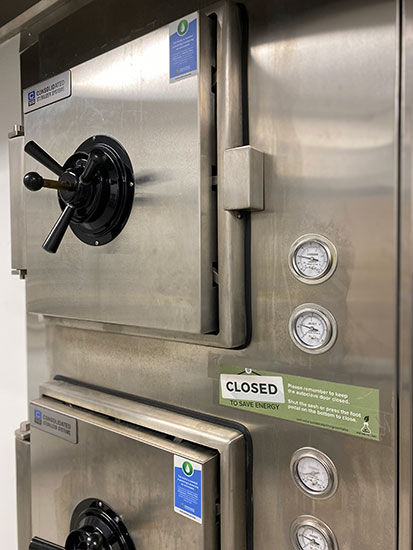 In addition to the floating freezer itself, Green Labs offers a free coil and filter cleaning service and tools for clearing frost. (To catch the water from a defrosting freezer with no mess, they recommend buying highly absorbent puppy training pads available from Walmart, PetSmart and elsewhere.)
In addition to the floating freezer itself, Green Labs offers a free coil and filter cleaning service and tools for clearing frost. (To catch the water from a defrosting freezer with no mess, they recommend buying highly absorbent puppy training pads available from Walmart, PetSmart and elsewhere.)
2. Right-sizing sterilizers
Many labs contain an autoclave, also known as a sterilizer, which cleans glassware and other equipment for reuse. “They are incredibly resource-intensive,” Ciancio said. “They can use up to 550 gallons of water a day, when they are not in use. They use as much electricity per year as 50 homes. They are energy and water hogs.”
Ciancio and Colpack were curious about how often each sterilizer was being used. So “we went across campus and worked on a user log,” with the help of Green Labs participants, Ciancio said. “They are good for 12 cycles per day, but most were used for only two or three cycles a day. The throughput was four times what was needed.” Based on a survey of users in the Bevill Building, “we were able to go in and change the times on the autoclaves, reducing electricity and reducing water,” Ciancio said. In several cases, “we took something that was on 24/7/365 and now it is on only 10 hours a day.” (One autoclave is left on to ensure availability for those who need them into the night.) The Green Labs team also identified much more energy-efficient sterilizers; they are testing these lower-capacity options now and gathering data to help guide future purchases.
 STEVE WOOD / University Relations
STEVE WOOD / University Relations
3. Pipette tip box recycling — the next level
From the beginning of the Green Labs program, interns have collected the boxes of used pipette tips that are seen in every lab. “We have sent 20,000 pounds of pipette tip boxes and inserts for recycling over the life of the Green Labs program,” Colpack said. These used to go to a recycling location that re-purposed them as filler material. But now Colpack and Ciancio have located a new vendor that uses the old boxes to make new pipette boxes. “That reduces emissions by 30 to 40 percent,” Colpack said.
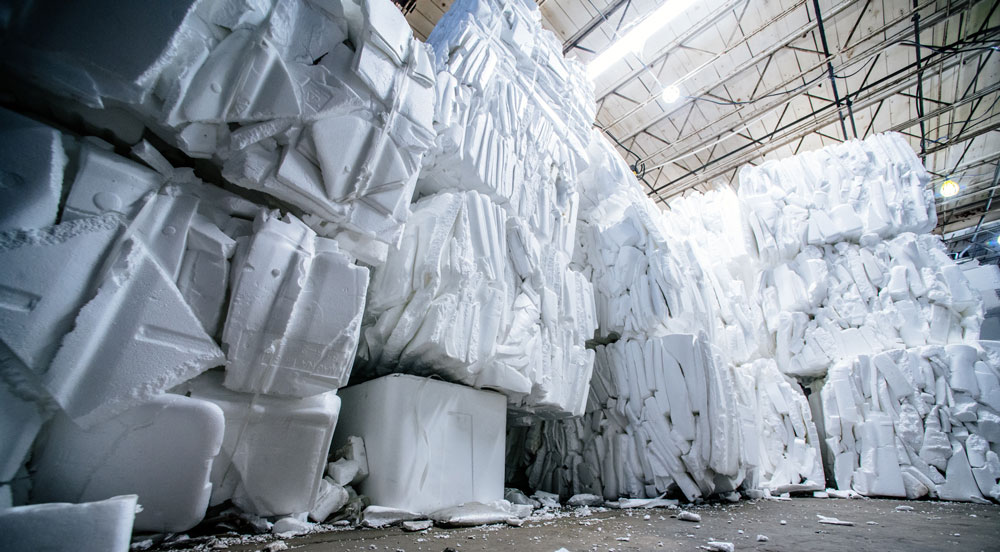 With a new Styrofoam baler, Green Labs has significantly increased its capacity for recycling the ubiquitous packing material.
With a new Styrofoam baler, Green Labs has significantly increased its capacity for recycling the ubiquitous packing material.STEVE WOOD / University Relations
4. Crushing that Styrofoam
Another new Green Labs service came online when Ciancio invested some of his budget in a Styrofoam baler, which compacts the bulky packing material for easier transport. “That has been a huge help,” Colpack said. “Styrofoam is 90 percent air, but it takes up a lot of space on a recycling truck. This machine compresses loads of Styrofoam into blocks that are 20 pounds each, so we can collect much more before we rent a truck to ship it to the recycling center. It helps us reduce costs and emissions.” (Due to high volumes, this service is open only to Green Labs participants.)
Story continues below box
Green Labs ROI
A handful of stats illustrating the return on investment from the UAB Green Labs program.
- 75,000 pounds of waste saved through the Green Labs program since it launched in 2017.
- 35,000 kilowatt-hours per year saved by the average Green Labs lab certified at the Green level, the lowest tier of the program. (Labs that make additional suggested changes can save much more.)
- Hundreds of thousands of gallons of water saved each year through new waterless condensers that replaced traditional condensers and vacuum pumps in four UAB chemistry labs.
- 20,000-plus pounds of pipette tip boxes and inserts recycled.
- 75 homes — the electricity saved by regular freezer maintenance is enough to power this many households annually.
- 200 pounds of ice packs monthly are collected by Green Labs and several organizations. Through a partnership with Birmingham’s Pepper Place, the ice packs are used by local farmers, who use them while delivering perishable items to customers; Meals on Wheels uses the donated ice packs to cool some of the 950 frozen meals it provides every week to homebound seniors in Jefferson County.
Helping lead a worldwide movement
The Green Labs team shares innovations proved at UAB with colleagues worldwide in presentations and conferences through the organizations it works with, My Green Lab and the International Institute for Sustainable Laboratories. Those two nonprofits coordinate the annual Freezer Challenge. In 2017, the first year of the Freezer Challenge competition, more than 200 labs across 34 organizations in North America took part. The latest competition, in 2022, involved more than 1,200 labs from 27 countries. Combined, they saved enough energy during the six-month contest to power more than 1,300 homes for one year. And though the Freezer Challenge is a fun competition, everyone is involved for the same reason, Ciancio notes. “It’s like a big family,” he said. “We are always learning and interacting with each other. If we learn that something we are doing is effective, we share it as widely as we can.”
Sustainable lab practices
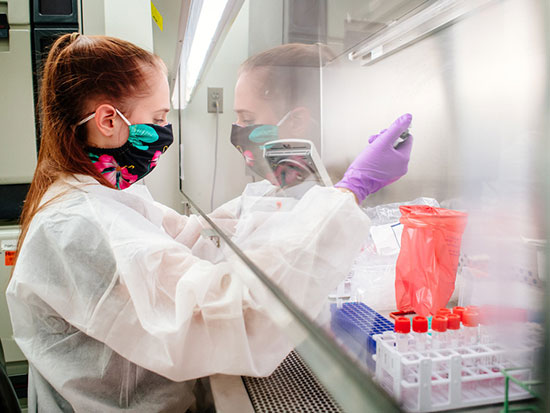 STEVE WOOD / University RelationsWhat types of changes does the Green Labs team suggest? The recommendations are unique to each lab’s setup, research and procedures, Ciancio says. (And as longtime Green Labs participant Lyse Norian, Ph.D., noted, “It’s up to us to determine what will and won’t work for our lab.”)
STEVE WOOD / University RelationsWhat types of changes does the Green Labs team suggest? The recommendations are unique to each lab’s setup, research and procedures, Ciancio says. (And as longtime Green Labs participant Lyse Norian, Ph.D., noted, “It’s up to us to determine what will and won’t work for our lab.”)
But there are several common changes that can add up to significant savings. Read about those below, and see sustainable purchasing recommendations in the UAB Green Labs Primer here.)
1. Perform regular freezer maintenance
Defrosting, changing freezer filters and vacuuming freezer coils can significantly reduce energy usage — enough that the Green Labs team now offers freezer vacuuming and cleaning to any lab on campus, not just to participants in the Green Labs program. “That is so critical that we have made sure everyone gets that,” Ciancio said. “Our researchers are so appreciative.”
- Another freezer best practice: Create and maintain a sample inventory of all samples in cold storage.
2. Close the fume hood sash
Fume hoods remove potentially harmful vapors and protect lab workers from splashes. “Almost every single lab room has one,” Colpack said. Leaving the fume hood open in between uses seems to make sense, but the fume hood is one of the most energy-intensive pieces of equipment in a lab. “A fume hood can use 3.5 homes’ worth of energy per year,” Colpack said. “When I was a student, I was told to shut the sash, but not why. It made sense to keep it open, I thought. But the way I explain it now is to think about the air conditioner in your home. If it is summer and 100 degrees outside and you leave all your windows and doors open, all that cold air will escape and cost you a ton of money. If you are not actively using your fume hood, keep the sash closed.”
- The Green Labs program can supply signage to remind lab staff of the importance of closing the sash when the fume hood is not in use. Contact
This email address is being protected from spambots. You need JavaScript enabled to view it. .
3. Turn off equipment when not in use
Use outlet timers and power strips on applicable equipment.
- Post signage and stickers indicating when equipment should be turned off and any necessary “shut-down, start-up” procedures.
Unplug equipment that is not regularly in use.